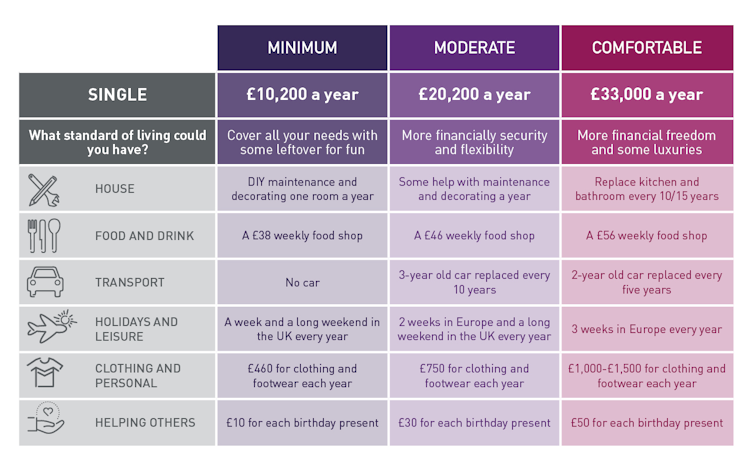£10,200 a year at a minimum

The earlier you start saving for retirement, the better.
Shutterstock
Matt Padley, Loughborough University and Claire Shepherd, Loughborough University
Retirement is changing. Following more than a century of increases in life expectancy, one in every five people in the UK is 65 years and over. This ageing population presents some big challenges, not least when it comes to financial planning.
To provide people with a sound basis on which to make decisions about the kind of life they want in retirement – and how much they will need to pay for it – colleagues and I have spent the past year and a half working out two different levels of retirement living standards. We’ve spoken to 250 people, building on our wider research into what income is required for people to meet their material needs and participate in society.
For single retirees who want a minimum standard of living – to meet their basic needs and have a little left over for fun – we estimate that they need an annual income of about £10,200. For what people would consider a comfortable retirement, where you have more financial security and flexibility, they need an annual income of £33,000.
To work this out, our research asked a series of groups to discuss and agree detailed lists of goods and services that are needed to live at each living standard. This is not just what is needed, but how long each item lasts, where it would be bought and the kind of quality it is reasonable to expect.
Three different living standards
If you are a single retiree, we calculate that you’d need to spend about £10,200 to have a minimum standard of living. As well as covering essential needs such as shelter and groceries, this includes £15 to eat out once a fortnight as well as £10 a month for a takeaway. It is based on buying reasonably inexpensive clothing at supermarkets and cheaper high street shops, but looking after your feet with good quality shoes.
It includes the cheapest contract smartphone, an entry level laptop and the internet, all of which allows you to participate in the world and not feel excluded. It doesn’t include a car, but does include a budget of £20 for social activities each week as well as two short UK holidays each year.
This minimum living standard provided the starting point for discussions with groups about what higher standards would include. We asked members of the public to agree the key features of two living standards above the minimum, which were then discussed by our group participants.
A moderate retirement living standard is where you “know full well you can always maintain [the] minimum”. But is also about having greater freedom to do more of the things that you would like to do. As one participant put it: “You need to plan, but you don’t have to think about every penny.”
With this in mind, groups agreed that at this level a single retired person would need £20,200 a year. This includes a budget of £75 each month to cover eating out, takeaways and coffee and cake while out shopping. It also includes the cost of a pre-paid funeral plan – something not included at the minimum – as it was important for them to avoid being a financial burden on family and having peace of mind that this cost was covered. As one retired man put it, “having enough to bury yourself” is crucial.
A moderate standard also features a car, a £60 a month Sky package and £35 for social activities each week, all of which give greater choice and flexibility than at the minimum. Holidays at this level are a holiday in Europe each year as well as a UK city break.

Pensions and Lifetime Savings Association
Groups described the next level up from this as a comfortable retirement living standard. This is a standard that allows flexibility, particularly in terms of financial security and having the opportunity to help others. People were clear that retiring at this level would mean peace of mind, with a financial buffer so that if, for example, your fridge stopped working you could replace it without worrying about making spending cuts elsewhere. A single retiree would need £30,000 a year to achieve this.
Being comfortable in retirement means being able to do a lot of what you want to do, but groups were clear that this was not about limitless choice or unfettered spending. There was a clear sense that you were likely to be able to retire at this standard as a result of careful financial planning and that maintaining this level in retirement would require the same approach.
At this level, groups decided that a single retiree would need £50 a week for eating out, takeaway and more spontaneous spending such as lunch out after shopping. It might include help around the house, such as a gardener to cut the grass in the spring and summer and a window cleaner once a month. Holidays at this level add up to three weeks in Europe each year, and critically at this level, groups included a budget of £1,000 each year for helping others.
Starting point
These three levels provide a starting point to think about both what we want life to look like when we retire – and how much is needed to cover it. They’ve already been adopted by a number of high-profile pension providers and advisors, and we hope they will become an accepted element of pension planning.
Considering the full new state pension is currently £8,767.20, which you only get if you’ve made national insurance contributions for 35 years, it’s incredibly important to think about the future and plan accordingly. The earlier you start the better.
At the same time, we should not lose sight of the growing number of people already retired that do not have enough to meet their minimum needs – materially, socially, emotionally and psychologically. Society – and government – must step in to help them, as well as encouraging and making it easier for people to better financially plan for their futures.
Matt Padley, Research Fellow, Centre for Research in Social Policy, Loughborough University and Claire Shepherd, Research Associate, Centre for Research in Social Policy, Loughborough University
This article is republished from The Conversation under a Creative Commons license. Read the original article.